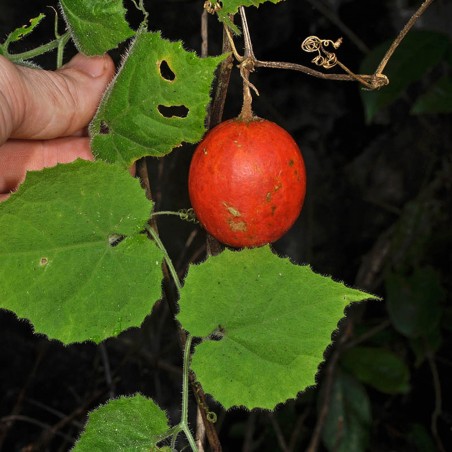
Japanese snake gourd seeds (Trichosanthes pilosa)
Japanese snake gourd seeds (Trichosanthes pilosa)
Price for Package of 5 seeds.
A climbing plant in the pumpkin family with thin shoots, lobed leaves, and white flowers with frilly edges, followed by round, bright red fruits that hold seeds coated in slimy black mucus. Trichosanthes pilosa is widespread from the Himalayas
Japanese snake gourd seeds (Trichosanthes pilosa)
Price for Package of 5 seeds.
A climbing plant in the pumpkin family with thin shoots, lobed leaves, and white flowers with frilly edges, followed by round, bright red fruits that hold seeds coated in slimy black mucus. Trichosanthes pilosa is widespread from the Himalayas to tropical eastern Asia to 1300 m. The roasted seeds are a popular snack in parts of Asia.
Japanese snake gourd is a perennial, climbing plant producing stems that can sprawl over the ground or climb into other plants for support, attaching themselves by means of tendrils.
The plant is cultivated, especially in China, for its edible fruit and root, and also for traditional medicinal purposes
Cultivation Details
Requires rich well-drained soil and plenty of moisture in the growing season.
Edible Uses
An edible starch is obtained from the root.
The immature fruit is preserved in salt. The mature fruit is about 7cm long.
Medicinal
Yields the protein hetero-trichosanthin, with 1.7 times the abortifacient activity of trichosanthin from the related species T. Kirilowii.
Diuretic
The root is anodyne, antiphlogistic, blood purifier, depurative, febrifuge, and resolvent. It is used as a poultice or made into a decoction to treat abscesses, boils, fevers, sore throats, etc.
The fruit is used to treat coughs, diabetes, jaundice, etc.
Other Uses
The dried fruit is rich in saponins and is used as a soap substitute.
An industrial starch is obtained from the root.
Propagation
Seed - sow March in pots in a warm greenhouse in rich soil. Sow 2 - 3 seeds per pot and thin to the strongest plant. Grow them on fast and plant out after the last expected frosts. Give some protection, such as a frame or cloche, until the plants are growing away well.
| HEIRLOOM ? | Yes |
|---|---|
| Organic Seeds ? | Organic Seeds |
| Organic/natural ? | Organic/Natural: Yes |
| Edible ? | Edible |
| Pretreatment of sowing ? | Soak in water before sowing 12-24 h |
| Sowing depth ? | Sowing depth 5 mm |
| Handpicked seeds ? | Handpicked seeds |
| Medicinal Plant ? | Medicinal Plant: Yes |


Your review appreciation cannot be sent
Report comment
Report sent
Your report cannot be sent
Write your review
Review sent
Your review cannot be sent
🌍 Worldwide Shipping from the EU
We ship worldwide from the European Union using registered air post with signature confirmation on delivery.
📦 Tracking Your Order
Log in to your account and go to Order History > Details to find your tracking number.
You will receive email notifications at every step — please check your spam/junk folder if you don’t see them.
Track your package via:
⚠️ Important Notices
Cash on delivery is not available.
Always provide a valid mobile number with country code when ordering (e.g., +365 456 7686 576).
Do not order to P.O. Boxes or if you cannot be home to sign for the package. We cannot leave parcels with neighbors.
If a package sent to a P.O. Box is lost or undelivered, you lose the right to a refund.
📦 Lost, Returned & Reshipping Packages
For customers in Brazil and Mexico:
We cannot refund packages lost or destroyed by customs.
If your package is returned, we will refund only the product cost — shipping costs are not refundable.
You must pay return postage (€2) and any costs for reshipping.
If a package is returned to us for any reason, you are responsible for paying the return shipping (€2) plus the cost to resend the package.
🚚 Shipment Delivery
Registered shipments require a signature from the recipient.
If your tracking shows the package is still at the origin post office, it means the package is in transit — please contact your local post office directly for updates.
We are not responsible for delivery times and cannot track shipments for you.
📅 Delivery Options & Estimated Times
Delivery Option Processing Time Notes Priority Delivery Ships in 1-7 business days Prioritizes order processing (not guaranteed faster delivery); delays possible during holidays (3-10 days) Secured Delivery Ships in 1-7 business days Available for orders up to €150; refund if lost Standard Delivery Ships in 7-10 business days More economical; delays possible during holidays (7-14 days) Estimated Delivery Time:
Within the EU: 3–20 days
Worldwide: 5–30 days
Example delivery times to the USA:
Delivered in 13, 17, 19, 22, or 27 days.Note: Delivery times depend on your location and the local postal system. COVID-19 may cause additional delays.
💰 Shipping Costs
Shipping and handling fees are calculated automatically during checkout based on the weight of the parcel and the destination country.
⏰ Order Processing Hours
We do not process or ship orders on Saturdays or Sundays.
💳 Payment Options
Bank Transfer (SEPA / IBAN / SWIFT-BIC)
Include your order reference in the payment description (e.g., "SGS-19811702"). Orders without payment within 7 days are automatically cancelled.PayPal
Payments accepted in Euros only. Please select Euros at checkout.Card Payment
For card payments, visit our other site: Exotic Seeds Store
We accept Visa, MasterCard, American Express, CB, Diners Club, Discover, China UnionPay, JCB, and Discover.
⚠️ Transaction Fees
Customers are responsible for any transaction fees. Please provide payment details to help us process your order efficiently.
📢 Final Notes
Before placing your order, please check our website for any special notices, holiday schedules, or specific conditions that may affect your purchase.
Related Products





















